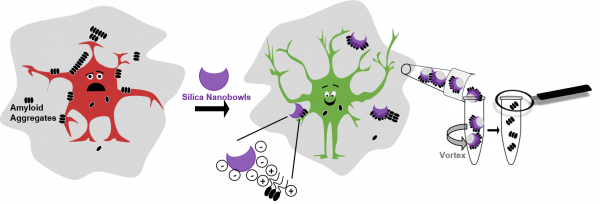Mar 1 2021
Researchers still have a long path to tread before they can treat Alzheimer’s Disease, partially because the protein aggregates that can turn into brain plaques, a characteristic attribute of the disease, are challenging to analyze.
 The amyloid beta protein that tangles to form the hallmark Alzheimer’s brain plaques, cling to ultra-small “bowls,” called nanobowls, scientists find. They can use these nanobowls to remove the toxic amyloid aggregates and further study them. Image Credit: Vrinda Sant.
The amyloid beta protein that tangles to form the hallmark Alzheimer’s brain plaques, cling to ultra-small “bowls,” called nanobowls, scientists find. They can use these nanobowls to remove the toxic amyloid aggregates and further study them. Image Credit: Vrinda Sant.
The plaques are formed due to the amyloid beta protein, the shape of which gets altered and tangled in the brain. The investigation of these protein aggregates in tissue samples often requires techniques that can disrupt them further, which makes it hard to figure out what occurs there.
However, a new study by Vrinda Sant, a graduate student, and Madhura Som, a recent PhD graduate, in the lab of Ratnesh Lal at the University of California, San Diego, offers a new method for investigating amyloid beta and could be valuable in future Alzheimer’s treatments. Sant and her collaborators presented their study on February 26, at the 65th Annual Meeting of the Biophysical Society.
Researchers have been analyzing the viability of using nanoparticles—which are ultra-small structures that can be coated in therapeutics—to offer targeted treatments for several diseases. Nanoparticles find various potential applications, for example, they can be coated with chemotherapy agents and targeted to a tumor for cancer treatment without any harmful side effects for the remaining body.
Sant started investigating bowl-shaped nanoparticles, which she names “nanobowls,” as a promising means to provide treatments for Alzheimer’s Disease. Sant predicted that the nanobowls should be coated in some kind of pharmaceutical to enable them to alleviate the amyloid beta protein plaques that cause Alzheimer’s.
However, the amyloid beta proteins get fixed to the nanobowls even when they were just coated in a lipid-polymer without adding pharmaceuticals. This enabled the researchers to eliminate the harmful protein aggregates from the cells.
We were surprised to find that the nanobowls were therapeutic themselves.
Vrinda Sant, Graduate Student, University of California, San Diego
According to Sant, although the use of nanobowls as therapeutics for Alzheimer’s Disease can be promising, at present, it serves researchers who intend to gain better insights into the amyloid beta aggregates.
As part of their recent study, Sant and her team identified that several forms of amyloid beta aggregates co-occur and not all forms directly transform into amyloid plaques, which confirms what was previously a theory in the field.
Currently, the researchers are working on the use of nanobowls to extract and further investigate amyloid beta protein aggregates. Since amyloid beta is implicated in cancer, cardiovascular conditions, and neurodegenerative diseases, nanobowls hold the potential for various diagnostics and treatments.